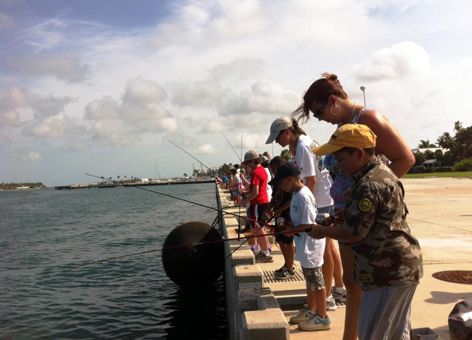After an Oil Spill, Why Does NOAA Count Recreational Fishing Trips People Never Take?
MARCH 7, 2014 -- From oil-coated birds to oil-covered marshes, the impacts of oil spills can be extremely visual. Our job here at NOAA is to document not only these easy-to-see damages to natural areas and the birds, fish, and wildlife that live there. We also do this for the many impacts of oil spills which may not be as obvious. For example, after spilled oil washes on shore, people often can no longer swim, picnic, or play at that beach. Or you may see fewer or no recreational fishers on a nearby pier.
Restoring Nature’s Benefits to People
After a spill, these public lands, waters, and wildlife become cut off from people. At NOAA, we have the responsibility to make sure those lost trips to the beach for fishing or swimming are documented—and made up for—along with the oil spill's direct harm to nature. Why do we collect the number of fishing trips or days of swimming that don't occur during a spill? It's simple. Our job is to work with the organization or person responsible for the oil spill to make sure projects are completed that compensate the public for the time during the spill they could not enjoy nature's benefits. If people did not fish recreationally in the wake of a spill because a fishery was closed or inaccessible, opportunities for them to fish after the spill need to be increased. These opportunities may come in the form of building more boat ramps or new public access points to the water. Working with our partners, NOAA develops restoration plans that recommend possible projects that increase opportunities for and public access to activities such as fishing, swimming, or hiking. We then seek public input to make sure these projects are supported by the affected community. The funding for these finalized restoration projects comes from those responsible for the spill.
What Does This Look Like in Practice?
On April 7, 2000, a leak was detected in a 12-inch underground pipeline that supplies oil to the Potomac Electric Power Company's (PEPCO) Chalk Point generating station in Aquasco, Md. Approximately 140,000 gallons of fuel oil leaked into Swanson Creek, a small tributary of the Patuxent River. About 40 miles of vulnerable downstream creeks and shorelines were coated in oil as a result. We and our partners at the State of Maryland assessed the impacts to recreational fishing, boating, and shoreline use (such as swimming, picnicking, and wildlife viewing). We found that 10 acres of beaches were lightly, moderately, or heavily oiled and 125,000 trips on the river were affected. In order to compensate the public for these lost days of enjoying the river, we worked with our partners to implement the following projects:
- Two new canoe and kayak paddle-in campsites on the Patuxent River.
- Boat ramp and fishing pier improvements at Forest Landing.
- Boat launch improvements to an existing fishing pier at Nan's Cove.
- Recreational improvements at Maxwell Hall Natural Resource Management Area.
- An Americans with Disabilities Act (ADA)-accessible kayak and canoe launch at Greenwell State Park.
For more detail, you can learn how NOAA economists count and calculate the amount of restoration needed after pollution is released and also watch a short video lesson in economics and value from NOAA's National Ocean Service.
 An official website of the United States government.
An official website of the United States government. 
